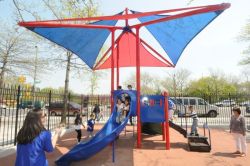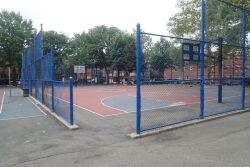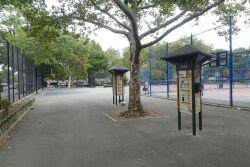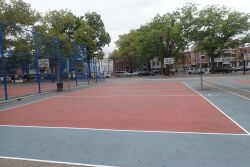Corona Golf Playground
Corona Golf Playground
The history of Corona is intimately tied to the arrival of the Long Island Rail Road in this area in 1854. When speculators from New York City began developing the settlement during that same year, they planned the streets in accordance with the railroad route. The tiny village was called West Flushing in remembrance of the Flushing Remonstrance, a landmark document drafted by Quakers 200 years earlier that called for religious freedom in America. The town grew quickly in population and in self-importance, and in 1872, the village decided upon a name it could claim as its own. Corona, a Latin term for "crown," was chosen because the town's settlers considered their home the corona of all Long Island municipalities.
Corona continued to grow during the boom years of the early 1900s. Its population reached 2,500 by 1898 and 6,200 by 1910, and the introduction of rapid transit in 1917 spurred further growth. Later in the century, Corona boasted several famous residents. The neighborhood was home to the great jazz trumpeter Louis Armstrong (1901-1971), who resided here from 1943 to 1971, and it was the fictional abode of Archie Bunker in the popular '70s television sitcom "All In The Family."
The land that is now Corona Golf Playground was previously a strip of wasteland, known as the Corona Ash Dumps. In his classic novel The Great Gatsby, F. Scott Fitzgerald described the area as "a valley of ashes - a fantastic farm where ashes grow like wheat into ridges and hills and grotesque gardens."
The City of New York acquired the property for Flushing Meadows Park in two parcels: on July 7, 1934, and May 15, 1936 -- and immediately conveyed both parcels to Parks which then built a golf course on the property. In the late 1930s, Parks developed the land into a recreational facility for all ages. Soon thereafter, this playground opened, equipped with an auditorium, swimming, and wading pools, a field house, ball fields, and a playground containing swings, slides, and gymnastic equipment.
This park was officially part of Flushing Meadows-Corona Park, site of the 1939 World's Fair grounds. In February 27, 1980, when it was reassigned to conform with coterminous districts, it became an independent park. A local law named it Corona Golf Playground. Bounded by 109th Street, 46th Avenue, and 47th Avenue, Corona Golf Playground is equipped with several basketball courts, a big open play area, two handball courts, three jungle gyms, two box-ball courts, and a public restroom. It also boasts swings, slides, benches, game tables, London planetrees, and dolphin and turtle statues, which create an aquatic atmosphere a flagpole, and a yardarm that flies the American, City of New York, and Parks flags. In 1998, Council Member Helen M. Marshall funded a $234,911 reconstruction of Corona Golf Playground, laying down new safety surfacing and repairing the park's facilities.
Check out your park's Vital Signs
Clean & Safe
Green & Resilient
Empowered & Engaged Users
Share your feedback or learn more about how this park is part of a
Vital Park System









